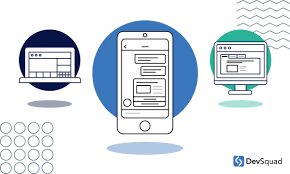The Evolution of User Interfaces
User interfaces (UI) have come a long way since the early days of computing. From command-line interfaces to graphical user interfaces (GUI) and now to touch-based interfaces, the evolution of UI has been driven by the need for more intuitive and user-friendly interactions with technology.
Command-Line Interfaces (CLI)
In the early days of computing, users interacted with computers using command-line interfaces. Commands had to be typed in text form, requiring users to memorise specific commands and their syntax. While efficient for experienced users, CLI was not very user-friendly for novices.
Graphical User Interfaces (GUI)
The introduction of GUI revolutionised how users interacted with computers. GUIs replaced text-based commands with visual elements such as icons, windows, and menus. This made computing more accessible to a wider audience by providing a more intuitive and visually appealing way to navigate and operate software.
Touch-Based Interfaces
With the rise of smartphones and tablets, touch-based interfaces have become increasingly prevalent. Users can interact with devices by tapping, swiping, and pinching on touchscreens, making interactions more tactile and engaging. Touch-based interfaces have transformed how we interact with technology in our daily lives.
The Future of User Interfaces
As technology continues to advance, the future of user interfaces holds exciting possibilities. Augmented reality (AR), virtual reality (VR), voice recognition, and gesture control are just some of the emerging technologies that are reshaping how we interact with digital devices.
Ultimately, user interfaces play a crucial role in shaping our digital experiences. By focusing on usability, accessibility, and aesthetics, designers can create interfaces that enhance user engagement and satisfaction. The evolution of UI is an ongoing journey towards creating seamless and delightful interactions between humans and technology.
Frequently Asked Questions About User Interfaces
- What are the 3 types of user interface?
- What is basic user interface?
- What are the 5 interfaces?
- What is the meaning of UI?
What are the 3 types of user interface?
When it comes to user interfaces, there are three main types that are commonly recognised: command-line interfaces (CLI), graphical user interfaces (GUI), and touch-based interfaces. Command-line interfaces require users to input text commands to interact with the system, while graphical user interfaces utilise visual elements like icons and windows for a more intuitive experience. Touch-based interfaces, on the other hand, rely on gestures and taps on touchscreens for navigation and interaction. Each type of interface offers unique advantages and caters to different user preferences and needs in the ever-evolving landscape of technology interaction.
What is basic user interface?
A basic user interface refers to the fundamental components and interactions that allow users to interact with a system or software. It typically includes elements such as menus, buttons, icons, and navigation controls that enable users to perform tasks and access information easily. A basic user interface focuses on simplicity and intuitiveness, aiming to provide users with a straightforward and user-friendly experience. By incorporating clear layouts, consistent design patterns, and minimalistic features, a basic user interface aims to enhance usability and ensure that users can navigate the interface efficiently.
What are the 5 interfaces?
The question “What are the 5 interfaces?” often arises in discussions about user interfaces. In the context of user interface design, the term “interfaces” can refer to various types of interactions between users and technology. The five main interfaces commonly referred to include graphical user interfaces (GUI), command-line interfaces (CLI), touch-based interfaces, voice-controlled interfaces, and gesture-based interfaces. Each interface type offers unique ways for users to interact with devices or software, catering to different preferences and needs for intuitive and efficient user experiences. Understanding these interface options is essential for designers and developers seeking to create user-friendly and engaging digital products.
What is the meaning of UI?
The term UI, short for User Interface, refers to the point of interaction between a user and a digital device or software application. It encompasses the visual elements, controls, and functionalities that enable users to interact with and navigate through a system. A well-designed UI aims to provide an intuitive and user-friendly experience by presenting information in a clear and accessible manner. Effective UI design plays a crucial role in enhancing usability, efficiency, and overall user satisfaction with technology products and services.
